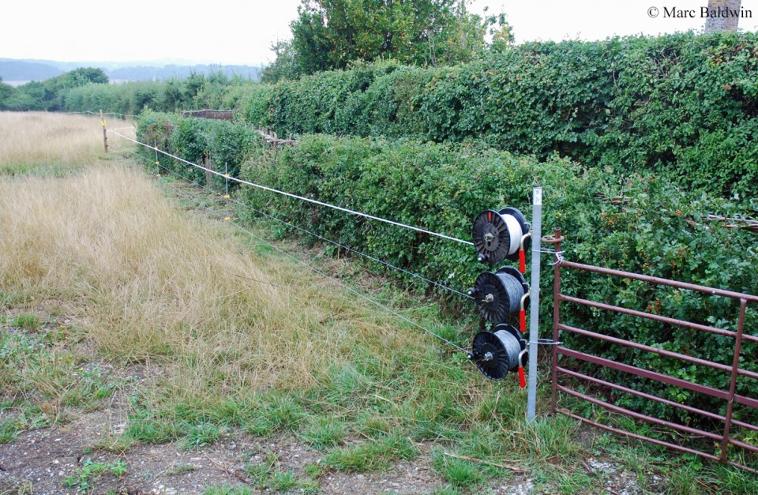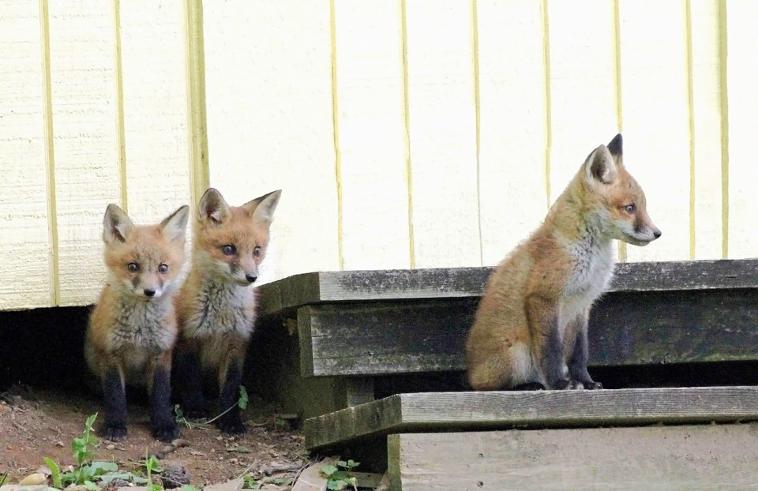
Watching & Deterring Wild Foxes
by Marc Baldwin - Wildlife Online (all rights reserved by author)
At Black Foxes UK, we are often asked for advice on observing or deterring wild foxes. Wildlife photographer, blogger and naturalist, Marc Baldwin, has kindly provided our readers with a helpful article and some handy tips for those seeking more information.
If you are concerned about the welfare of a wild fox which requires rescue and rehabilitation, then please contact your local wildlife charity, a dedicated fox charity or the RSPCA, as soon as possible. Do not attempt to take on the responsibility yourself.
If you are concerned a visiting fox may be a missing exotic pet (foxes with an usual colouring or appearance, that are out during unusual hours or with little road awareness, and are seeking human contact), then please contact Black Foxes UK to Make a Report.
Fox-Watching: Tips on Observing Wild Foxes
Growing up in Sussex, some of my earliest wildlife encounters involved foxes - from the fox that tried to make off with one of our pet ducks in broad daylight, to countless cold nights spent in the car with my Mum trying to photograph them. While it’s true that some people hate foxes, I think that many more get tremendous pleasure from watching them. From personal accounts and stories I’ve seen over the years, it is clear that simply being around and interacting with foxes has helped some people through emotionally dark times.
If foxes are present in your area, how do you go about finding and observing them?
Foxes are social mammals and, contrary to the loner image that is widely portrayed in literature, it’s not uncommon, where resources allow, to find them living in family groups. Indeed, social groups are relatively common in urban areas where food and shelter is easier to come by. These groups typically include the breeding male and female along with daughters from previous litters, although there are examples of sons having also remained on the family territory into maturity.
Wherever you find foxes, whether they’re living as a pair or in a larger family group, a consistent facet of fox behaviour is that they maintain a territory. A territory is an area of land over which the animals range and from which interlopers will be repelled. Territory sizes vary hugely according to resource availability, tending to be smallest in towns and cities and largest in moorland. This territoriality is great for fox-watchers, because if a fox is going to stake a claim on a territory, it needs a way of telling others that the place is occupied. Foxes do this with a combination of scent and vocalisations, which can be used to help locate them and identify their presence.
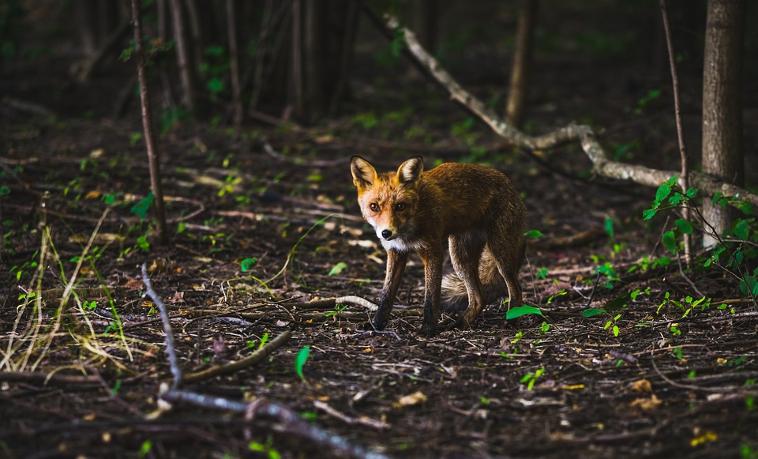
Give Me a Sign
Seeing a fox in the flesh is great, but many of us only get a fleeting glimpse that tells us little more than that there may be foxes in the area. (I stress may because there are also itinerant individuals - nomads without a home range.) Ergo, if we’re to establish fox residence we need to look for clues to their presence - droppings, paw prints, hair caught on fences, barking, dens/earths. We call these things field signs. Field signs are generally easier to spot in rural locations because urban foxes spend much of their time in private gardens; using fences and walls to move around, essentially unnoticed.
Fox paw prints are distinctive and, with a little practice, easily distinguished from those of domestic dogs and cats. Fox paws are oval shaped, longer than wide, with a heel pad at the base and four toe pads arranged above. Cats have a broad heel pad with the toes arranged in a line along its upper edge. Domestic dogs have a more circular paw shape but with a very similar pad arrangement, the main difference being that the toe pads of foxes don’t intersect. If you can draw a line between the top and bottom two toe pads without cutting into either pad mark, you’re almost certainly looking at a fox print.
Another key fox indicator is fox scat (fox poo), which is used as a territorial marker. Fox poo and the fluid that’s often squirted on it carries a wealth of information about the animal who left it, a bit like a calling card for any passing foxes. The consistency of fox poo is hugely variable according to what the animal has been eating, but it is often a small pile of between one and three “sections” several centimeters long and about a centimeter thick. The droppings will typically have obvious fur/feathers and bone fragments, and will taper at one end into a short twist of fur. Perhaps more distinctive is the placement - foxes deposit their droppings on conspicuous objects in the environment, such as on tree stumps, tufts of grass, at path intersections, on the remains of prey and, in urban areas, shoes, doorsteps and garden gnomes.
Battle of the scats. The scat of geese (left) or cats (middle), is often confused with fox scat (right):
If you locate an earth or den, there will likely be droppings in the immediate vicinity of the holes, as well as the remains of food. The entrance hole will be a vertical oval, much like their paw print, it is taller than it is wide. A badger sett, by contrast, will have horizontal oval entrance holes (wider than tall) and will have latrine pits, large spoil heaps and scratched trees in the vicinity. That said, foxes will sometimes complicate earth identification either by taking over an abandoned badger sett or rabbit warren, or in some cases cohabiting with badgers. Earths can be almost anywhere, although in my experience they’re typically in easily-diggable (sandy) soil, close to a water source, and very often within or very close to some dense cover, especially gorse or bramble. In upland areas, foxes will den between boulders in a scree slope, and there are even reports of earths built in pollarded trees; foxes are nothing if not versatile! In many cases, when you find an earth it will be fairly obvious.
If you do manage to locate any of these field signs, you will know that you have struck it lucky and that foxes are present in the area.
Proper Preparation
Once you’ve established there are foxes at your location, be it a potential earth, the remains of a carcass on which a fox has been feeding or even just a path that looks like a potential fox highway, the next step is to stake it out and see what arrives.
Before you grab your coat, though, there are a few things to take into consideration:
-
If your destination is a potential earth, give some consideration to the time of year. Earths are used primarily for the purpose of raising cubs, so care is necessary not to disturb the family. Earths are largely abandoned by the time the cubs are weaned . This means that any vigil between late August and late February is likely to be unfruitful, although cubs may remain in the vicinity. During March the vixen will spend most of her time underground with the cubs, but you may see the dog, and sometimes other family members, bringing her food. Come April the cubs will start appearing above ground, however, May and June are arguably the best months for fox-watching.
- In urban settings foxes tend to be more diurnal (i.e. active during the daytime) than in rural areas, particularly where they’re heavily persecuted by farmers and gamekeepers, so you stand more chance of spotting your fox early in the morning or late in the afternoon/evening. The exception tends, again, to be March to May or June when parents are forced into round-the-clock action by hungry cubs.
- December and January are the fox breeding season and it’s during these months that they’re most mobile and vocal. If there are foxes in your neighbourhood, a night-time walk should yield the eerie mating screams, fighting gekkering and wow-wow-wow contact barks of courting foxes. They’re also more likely to be seen moving in pairs at this time of year.
- By August the cubs are almost fully grown and will be moving around either on their own or in pairs; often leaving their daytime nap spots before Mum and Dad, they can be seen playing and hunting in early evening.
- Foxes are pretty hardy and not a lot puts them off, but they’re much more nervous on windy nights and hot weather will make them, like most of us, very lethargic and likely to be lying up in cover, both of which will affect your chances of observing them.
- Juvenile foxes are less proficient at catching prey, specifically birds and mammals – like most things, these are skills that must be honed. As such, they’re often drawn to “easy pickings”. July and August is the peak time for harvesting and, in my experience, an early morning or late evening trip to a recently harvested/mown field has a very high probability of encountering a fox looking to pick off the mice and voles recently made homeless by the combines and mowers.

So, you’re now clued up as to where you need to be going and when. What now?
The first step is to visit the location several times in daylight and familiarise yourself with the layout. Things can look very different in the dark and it’s important to be familiar with the surroundings, particularly the route to and from your chosen vantage point. Once you’re confident, you’ll want to be in position about an hour before sunrise or sunset, depending on your chosen observation period. Approach from downwind, select your spot and sit and wait. Your waiting spot should be close enough to the focus point (earth, path, carcass, etc.) to have a decent view, but not so close as to risk disturbing your subject. Hide yourself as best you can. Choose warm clothing that doesn’t rustle and sit with your back against a bush, tree trunk or wall to help break up your silhouette. If possible, wear a hat/scarf/scrim to cover your face.
You’ll want to be kitted out in comfortable clothing, as it may be a long wait, and you’ll need binoculars (10x8 are a good choice). I would strongly advise against taking camera gear on your first couple of visits – spend the time watching and getting familiar with the animals, rather than worrying about trying to get a photo. Hopefully there will be plenty of time for that on subsequent visits. In the early stages, depending how used to people these foxes are, you’ll probably find the they’re wary. If you’re spotted by the fox(es), remain still and, provided you’re down wind, you may well find that the fox looks for a few minutes and then carries on with its business. If your presence startles the fox, causing it to bolt when it sees you, you need to find an alternative vantage point, either further back or better camouflaged.
When it comes to watching foxes, Martin Hemmington sums up the need for patience excellently in Fox Watching, when he says:
“If you have not got the slightest bit of patience, rather than going home early, do not bother even going out in the first place; only patience will be rewarded.”
Of course, this is not always the case, and I have seen foxes appear after only a few minutes of watching. At the same time, however, I have sat watching an earth for hours, acting as a smorgasbord for every biting insect in the Forest, and seen nothing. On the whole, though, you can expect to be waiting for more than an hour for most rural foxes to put in an appearance.
In urban settings the situation may be vastly more comfortable if there are foxes visiting your garden. Start off by watching from an upstairs window – the foxes will know you’re there, but in my experience seem less concerned about high-level viewing than they are being viewed at ground level. Over time, as the foxes get used to you and your garden, you can start watching from downstairs, initially with the lights off and windows closed but progressively with the windows open. I know some householders whose foxes are sufficiently comfortable in their presence to come into the garden while they’re sitting outside, provided there are no sudden movements.
The Hungry Fox: To Feed or Not to Feed?
I’ve have heard it said many times that urban foxes thrive on our waste and that the introduction of 'fox-proof' wheelie bins by many local councils has meant that our urban foxes are starving. This, apparently, explains why foxes are growing bolder and are more frequently seen in gardens. This is a subject I tackle in more depth on my website, but it is an important point so I will reiterate it here: yes, foxes will take advantage of our rubbish if presented with the opportunity, but foxes do not depend on bin scavenge. Moreover, there are no data to suggest that the implementation of wheelie bins has had any impact on the health or behaviour of foxes living in our towns and cities. Most dietary studies of urban foxes show that about one-third of the food they eat is “wild caught” (e.g. birds, small mammals, insects, fruit, etc.) even in metropolises such as London.
In addition to the food they can find or catch, a great many people feed foxes and, for the most part this doesn’t cause significant problems provided the food is appropriate and delivered in an appropriate manner and quantity. Problems can arise when people put out too much food or inappropriate food (such as cake, crisps, highly processed meats, etc.) or both. The problem with putting out a lot of food is that it can alter the foxes' behaviour.
When bountiful food is provided it can concentrate fox activity and, hence, amplify any disturbance they may be causing. They tend to move around less because they don't need to cover as much ground to get their daily rations, giving them more time to relax and play in and around the garden. They also start caching surplus food for later retrieval; some will be buried in the garden in which they're being fed, but more will end up in neighbouring gardens. Over a longer time, if food provision remains high, the foxes may reduce the size of their territories and this can lead to more foxes in the area. When food is abundant there is also often less pressure for cubs to disperse, resulting in an increase in family group size. Interestingly, recent work by Jo Dorning and Stephen Harris at Bristol suggests surplus food affects female more than male behaviour.
Everyone has their opinion on whether it’s right to feed foxes and the right and wrong way to do it. In the end, the advice will vary based on the fox(es) you're feeding, where you live, and how tolerant your neighbours are of wildlife. In my experience, a couple of handfuls of peanuts or dog biscuits sprinkled around the garden every few days will keep the fox occupied long enough to get a decent view and probably some photos without having any significant impact on its normal foraging behaviour.
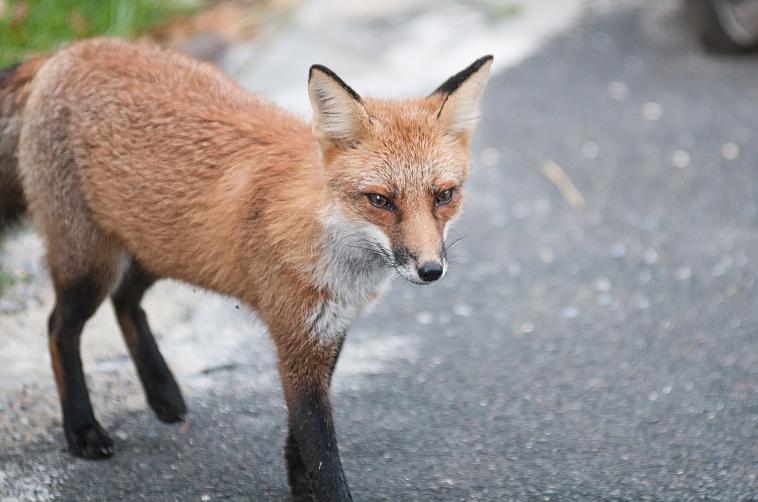
Hopefully this has inspired you to learn more about your local foxes. It can be frustrating at times, but patience is usually rewarded and you never know what you might see.
For those wanting to take their interest in foxes further, Martin Hemmington’s Fox Watching: In the shadow of the fox, provides a detailed insight into their lives along with instructions on further study (plaster casting, dropping analysis and so forth). Also, for a more scientific approach and with a slant towards North American red foxes, J. David Henry’s How to Spot a Fox is well worth a read.
Deterring Foxes: Tips on Preventing Human-Fox Conflict
How do I stop foxes fouling my lawn? Can I stop them digging in my flower beds? Foxes are eyeing-up my chickens/rabbits, what can I do?
These are questions councils, pest controllers and wildlife biologists hear all the time. Britain is generally a nation of animal lovers, but sometimes wild animals come into conflict with their human neighbours. This article investigates some of the options available to curtail or, possibly, eliminate fox visitation. The full version of this article can be found here: Deterring Foxes | Wildlife Online.
Let's be Honest
Foxes are a species with the power to polarise. Ask people what they think of foxes and you’ll get one of two answers: I enjoy seeing them and even feed those that visit my garden, or, they are disruptive vermin that cause nothing but trouble.
Wildlife biologists have a tough job addressing the conflict between people and foxes, partly because it’s difficult to calibrate nuisance. A fox pooing in a flowerbed may bother me less than it does you, for example, if you have young children who play in the garden and I do not.
Beyond differing tolerance thresholds, many people feel that their entitlement to quiet enjoyment of their property is implicitly extended to wildlife. They believe that they should be able to keep chickens in their gardens without fear of a fox getting in, that they should be able to park their cars with the reasonable expectation of not having the wiring chewed, and that foxes, like human visitors in the garden, should have the decency to poo somewhere else. None of these are innately unreasonable things to want, but nature doesn’t work like that. Wild animals exist outside social etiquettes and boundaries, because they have no concept of these human constructs. Consider how long it takes to train a dog or even a child what constitutes “acceptable” behaviour. It makes no sense to assume that “pests” such as foxes are born with the ability to intuit our expectations.
This may seem like an odd way to start an article on keeping foxes out of your garden, but it’s important to recognise that we bear the burden of deterrence. To quote Aminatta Forna;
“Only one party in the fox versus human battle was capable of changing its behaviour”
This means that we must take steps to stop the foxes doing whatever’s annoying us. And, because some foxes are more persistent than others, a stepped escalation of measures and some trial and error may be necessary to achieve the desired outcome.
It is also important to remember that foxes are highly seasonal animals and the fact that you have foxes in your garden now doesn’t mean they will be there in a few weeks/months. The disturbance isn’t necessarily permanent.

And, in the end, we must accept that it’s sometimes not possible to have our metaphorical cake and eat it. We may not, for example, be able to keep our chickens/rabbits/ducks free range without manning a 24-7 vigil. That said, in most cases it is possible to repel foxes. In the quest to deter nuisance foxes, a staged approach is recommended. First, remove or mitigate attractants. Second, restrict access. Third, deploy repellents.
Strong Arm of the Law
Before looking at some of the methods at your disposal, it’s worth briefly mentioning that foxes are protected under existing wildlife and animal welfare regulations in the UK, making it illegal to cause them “unnecessary suffering”. Without going into detail, in practical terms, this means it’s a criminal offence to gas, poison, stab, impale, beat, burn, crush, stone, drag or asphyxiate/suffocate foxes in the UK. It’s also against the law to trap them in anything but a humane trap, which must be regularly checked.
In this context, coupled with specific regulations pertaining to the purchase and application of pesticides, it’s also illegal to use tactics such as broken glass, air guns, and the application of strong-smelling substances such as turpentine, diesel, creosote and paraffin as a deterrent.
Rules of Attraction
Why are foxes coming into the garden?
Like us, foxes visit places for a reason – there’s something there that they want. Because a motivated fox will go to extraordinary lengths to get what it wants, there's no point in proceeding directly to restricting access. Begin by identifying what it is that attracts foxes and removing or cutting off access to it. If there is no reason for the fox to return, there may be no need for further counter-measures.
If, for example, the fox is visiting to drink from your pond or rummage in your compost heap, can you fence it off? If they’re picking up food spilled from your bird table, clear it up during the late afternoon. If you use a lawn fertilizer and it contains fishmeal or bonemeal, consider swapping it for one that doesn’t.
If foxes are visiting your garden for food, be that to feast on your blackberries or eye-up your chickens, rabbits, or other pets, there’s another method that has gained some apocryphal acknowledgment as a repellent: taste aversion. Taste aversion is the practice of getting animals to associate particular situations with an unpleasant taste or action (such as vomiting) and has been trialled in Australia, where foxes are significant predators of indigenous wildlife, with limited success. There are accounts of people who have put chicken pieces covered in very spicy marinade (Tabasco, chilli, mustard, etc.) in front of their coop and have found that the fox has taken one and never come back. Another used something similar (chilli-coated strawberries) to deter foxes from raiding her strawberry patch. There is some scientific corroboration of this as a deterrent and, about 20 years ago, David Macdonald and Sandra Baker found that three hand-reared orphaned fox cubs were less likely to sample a bowl of milk after they'd been presented with milk containing the bitter-tasting chemical denatonium benzoate, commercially known as Bitrex.
Physical Barriers: Keeping Foxes and Pets Apart
Electric Fencing/Netting
By far the most consistently effective method of predator exclusion involves the use of electric fencing. The technique has been used with great success to protect nesting bird colonies from the attentions of foxes. That said, behavioural observations from the Central Science Laboratory in Cheshire have shown that, even though foxes refused to cross the fences in most cases, the animals investigated them regularly and even after receiving a shock only stayed away for about an hour. The foxes investigated the fences with their nose, a highly innervated and sensitive part of their body, and most foxes were only shocked once; one was shocked twice, but none took more than two shocks to get the message. This helps illustrate that defences need to be maintained. Arguably, owing to the expense of installing and maintaining them, electric fences are only cost-effective for large areas, although they can be included in the design of animal housing (especially chicken coops) to add additional fox-proofing.
An electrified fence is basically an open circuit. When an animal touches the fence, it provides a pathway from the fence to the earth through which electrons pass, thereby closing the circuit. The 'shock' that an animal feels is a rapid muscle contraction in response to the electron flow. Animal fur is a poor electrical conductor and can insulate them against shocks delivered by electric fences if the voltage is set too low. Consequently, fences operate at a relatively high voltage, commonly between 4,000 and 5,000 volts, capable of overcoming the resistance of the fur. If you install an electric fence, you will need to strim around the bottom regularly to prevent grass or other vegetation short-circuiting it.
Note that wire of electric fences should be placed at least 15cm (6 in.) above the ground to avoid the risk of hedgehogs encountering them.
Cages
Ducks, geese, chickens, rabbits and guinea pigs should be put away at night in secure hutches or cages. When thinking about what constitutes “secure”, it is important not to underestimate how resourceful and persistent foxes can be. Hutches with simple twist closures are insufficient to prevent a fox gaining access. Each door must have at least one—ideally two, one at the top and one at the bottom—bolts that latch in place. Pets should be shut away at or before twilight.
Enclosures should consist of fences at least 2m tall, with an outward overhang at the top. The base of the fence should be electrified, buried in the ground (down to approx. 50cm (19 in.), or surrounded with paving slabs to prevent the fox digging underneath. Enclosures must be of sturdy construction and fitted with secure catches/locks. Perhaps the most important point to remember when constructing or purchasing a house for your livestock is that chicken wire is not sufficiently strong to keep a fox out and foxes can easily bite through it – it was designed to keep chickens in, not keep predators out. Fences should be composed of strong welded mesh, the lower the gauge the better – choose 12 or 14 gauge for maximum security. However you construct your coop/run, it is important that you regularly check it for weak spots (signs of digging/scratching/biting, rust/rot, loose fixtures and so forth) and repair them as they arise.
Routes of Access
If you’ve removed or protected the obvious, or at least known, attractants, and you’re still being visited, the next thing to look at is how foxes are getting into your garden. Foxes are medium-sized carnivores that are both reasonably proficient diggers and perfectly capable of scaling a two metre (6 ft.) fence from a standing start. Larger fences can also be cleared if handy props (bins, garden chairs, pots, boxes, etc.) are nearby to provide a boost. Foxes also have strong, sharp claws, allowing them to climb wire mesh with ease.
Check the perimeter of your garden for paw prints in the soil, squashed plants that may have been damaged by a fox jumping down, claw marks in the fence, holes under fences/walls/gates, etc. If you identify a hole, check along the bottom of the corresponding wall or fence for hairs. Once you’ve established the point of entry, can you make it more difficult for the fox to get in? Can you block up the hole or move any climbing aids?
Spiked Strips
For standard, non-electric fencing, it is possible to purchase “prickle” and “brickle” strips that line the tops of fences and walls, respectively, to deter animals climbing over them. Combining prickle/brickle strips with chemical repellents (described in the next section) applied to any entrance and exit holes in the garden, as well as to ‘take-off’ or ‘landing’ sites, probably constitutes the best program for preventing fox access.
It is also possible to obtain prickle sheets, known as “DigStoppers”, which can be placed on (or just under) the soil to discourage digging. They should not be used at landing points.
Deploying Repellents
If keeping foxes out is not proving as simple as removing/securing food sources and blocking a hole or moving a bin, the next step is deploying repellents - applying a “treatment” to deter the animal from climbing or digging its way into your garden. There are various chemical and physical repellents that can be used for foxes. (Note: Anti-climb paint used to deter burglars does not appear to deter cats and is consequently unlikely to work against foxes.)
In the UK, there are several chemical deterrents available. One of the most common is Scoot Fox Repellent, a powder that comes in sachets and you mix with water before spraying in your garden. Readymade equivalents to Scoot, such as McKlords Fox Repellent and Pestshield's No More Foxes sprays are also available. Get Off My Garden Cat & Dog Repellent is a gel that you apply to targeted areas of disturbance such as digging or landing points. In the USA you can also purchase citronella sprays.
Chemical Repellents
Chemical repellents tend to be ineffective at preventing losses of livestock, presumably because the sight of prey overrides the smell of the repellent, and against subordinate and itinerant (no fixed territory) foxes; the latter appear to behave differently to dominant animals, which can influence their response to repellents. Overall, however, The Fox Project, a fox rescue charity and advice service based in Kent, has found chemical repellents to be a useful method of deterrence and that consistent and appropriate use of repellents usually stops the dominant animals using the garden while keeping them in the area (i.e. just shifts their habitat use), which is important because if they stay in the territory they prevent new animals from moving in. Indeed, the use of chemical repellents should be targeted.
Earths Under Sheds
Soak straw or rags in a deterrent and use them to loosely block any entrance and exit holes. The fox will remove the obstruction, but replace it and keep doing so. When the blockage has not been removed for two days, you can be sure the foxes have moved out, and you can seal the hole permanently with stones, bricks, slabs or wire. It is important not to seal the hole before this because you might entomb the foxes, which would cause them to asphyxiate or starve – this is not only illegal under the Wild Mammals (Protection) Act, but it would also leave the bodies to decompose in situ.
Sheds and summerhouses are favoured outbuildings under which foxes build earths, particularly in urban areas (photo by Dottie Dowling):
Fouling and Digging
Foxes use their droppings (faeces) to mark their territory and objects within it. Poo is often deposited on or close to conspicuous objects (shoes, flower pots, stones etc.) where it is most likely to attract attention. Removal of the offending substance only leads to more being left, usually the following night, so the problem must be treated. It is suggested that you soak a small amount of sand or sawdust in a chemical repellent and place it next to the droppings, or apply it directly to the scat with a spray applicator.
As with fouling, a small amount of repellent-soaked sand or gel repellent can be placed it in holes dug in lawns or flowerbeds, or a repellent can be sprayed directly on to the ground being targeted. If there are children in the garden, you can purchase specialist human-neutral disinfectants (PX Parvo, for example - see Fox Solutions) for use on areas of fox fouling.
Of less proven efficacy is the application of substances such as predator urine/droppings or human urine. Several online retailers sell wolf urine and lion dung as fox (and cat) repellents, the idea being that small predators are put off by the presence of larger ones. From a purely practical perspective, foxes didn’t become the denizens of the city by being easily put off, and it is, further, highly unlikely that most foxes in Britain have ever encountered a lion or wolf before and evolved a learned aversion. Furthermore, foxes do not appear to particularly avoid wolves in areas where the species overlap and, ironically, actually do well as a result of reduced depredation from coyotes and by scavenging on wolf kills.
Anecdotal testimonies assert that male human urine is a good deterrent, but there is no readily available empirical evidence to support this, and the smell of either fox or human urine could become off-puttingly overpowering during the summer
Mechanical Deterrents
Sonic Deterrents
Several companies market ultrasonic (i.e. too high to be heard by the human ear) deterrents, the general idea being that they emit an ultrasonic sinus or siren-like sound which foxes find unpleasant for a pre-set period after the device is activated. The devices are usually triggered by movement or body heat registered via an infrared (night-time) sensor.
Many general purpose units have a broad frequency range (from about 8 to 40 kHz), which can be set according to the animal you're trying to repel. Those designed specifically to repel cats and dogs tend to operate at around 22 kHz, while those for rodents broadcast between 30 and 70 kHz. The units are usually battery operated, with a sensor range of around 12m (40ft) and an effective distance of (i.e. excludes animals from an area of) about 18m (60ft).
One widely sold ultrasonic device, aimed specifically at deterring foxes, is the FOXWatch unit produced by Concept Research in the UK. The product website makes some impressive claims, including that it is “without doubt, the most effective fox deterrent on the market”. Overall, the studies that have been conducted with ultrasonic repellents have been mixed, and scientific data demonstrating their efficacy as fox deterrents is not available.
Eye-Shine Models
Some devices rely on “spooking” the fox out of the garden, relying on reflective or light-emitting objects. These deterrents typically work by trying to fool the fox or cat into thinking it’s being watched. The manufacturers of one such repellent, NiteEyes, stated on their website that: “The sense of being watched is the greatest fear night animals have”.
Customer reviews on shopping websites suggest the device can be very effective, but foxes aren’t stupid animals and are not easily fooled. Most urban foxes seem to have little issue with humans watching them and it is unlikely that being watched is in fact their “greatest fear”. Some devices have conflicting statements on the manufacturer’s website, and the reviews on shopping sites suggest they’re ineffective at least as often as they appear to work.
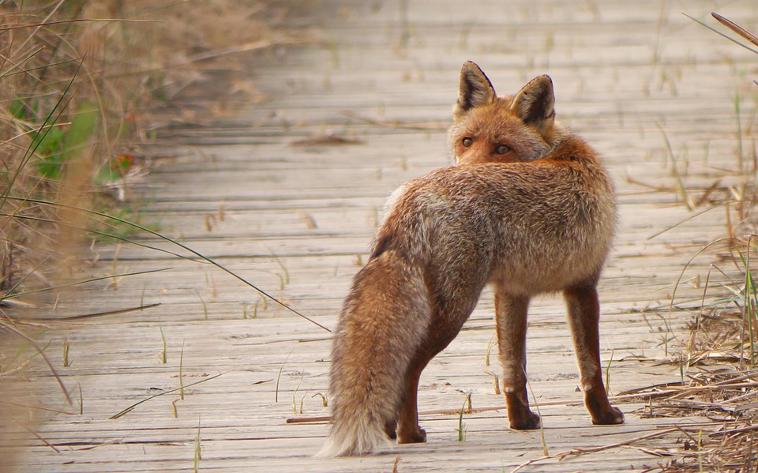
Water Jets
In his 2002 book Living with Urban Wildlife, former pest control officer John Bryant recommended a device called a Scarecrow for fox deterrence. The Scarecrow is a water-jet activated by an infrared sensor, sensitive to objects up to 11m (35ft) away – when triggered by movement it fires a three-second jet of cold water from its sprinkler head.
Mr Bryant explained that he has “found that it has deterred foxes that have defied all other repellents”, but points out that it can be triggered by any movement, including cats, dogs and plants swaying in the breeze. The Fox Project has also apparently used such devices with reasonable success, although we have all seen video footage of foxes digging in a lawn while being showered by a water jet.
Conclusion
There are attractant-reduction, access-restriction and repellent-deployment methods at your disposal for keeping foxes out of your garden. Foxes can be wily and persistent, and keeping them out of your garden may require the same from you. In a very apt comparison, The Fox Repellent Expert website makes the point that;
“One traffic jam wouldn’t make you stop using your preferred route to work.”
The operative point is, don’t give up. Use several deterrents and combine them with some common sense around restricting access to attractants in your garden.



